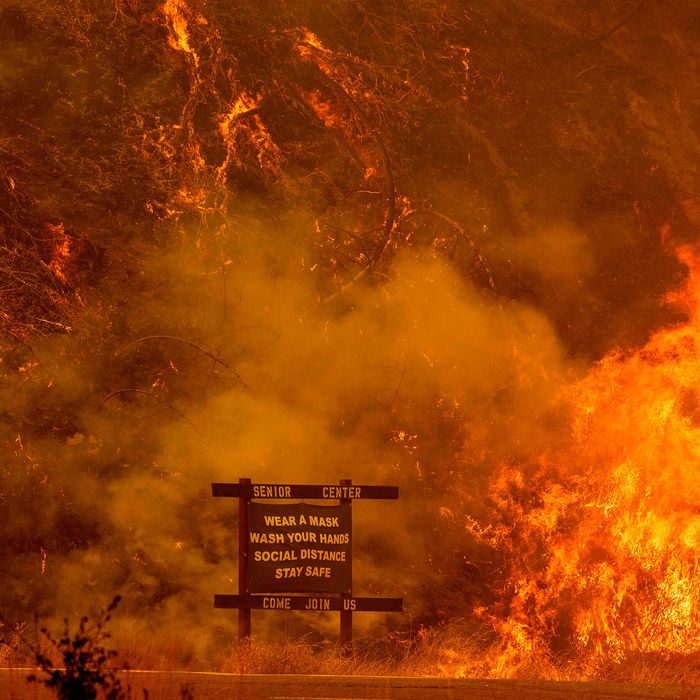
A sign for our times. Photo: Josh Edelson/AFP via Getty Images
California is Australia now. Beginning late last year, in what is already known as the country’s Black Summer, bushfires burned through 46 million acres, or 72,000 square miles; killed several billion animals, pushing a number of species to extinction or the brink of it; flooding Sydney with air so thick with smoke ferries couldn’t navigate its harbor and fire alarms in office buildings rang out, registering the smoke as proof the building itself was in flame; and forcing beachfront evacuations in scenes that crossed Dunkirk with Mad Max.
The situation today in California isn’t yet quite as grim, although this week CalFire advised every citizen of the state — all 40 million of them — to be prepared to evacuate. Already, more than 100,000 already have. When I first began writing this article, 500,000 acres had been burned in the state; when I finished writing it, the it was 600,000, and when it was done being edited, it was 700,000 — a number that would have been, in recent memory, a historically devastating year of fire. In just five days, more land had burned than in all of 2019. And the number kept growing—well past a million acres to 1.25 million. In the Bay Area, the two Lightning Complex fires — in wildfire terminology, “complex” is when multiple blazes join forces — are now the second and third most destructive fires in the state’s history. The Complex could burn as many as a million acres, it’s been suggested—the state’s first “gigafire.” The lightning storms that set it off simultaneously ignited so many other wildfires the state authorities couldn’t keep track of all of them, just the 376 most significant ones. All told, more than ten thousand lightning strikes were recorded in a single day; the week saw 560 wildfires start. Big Basin Redwoods State Park has been burned through, prompting a conservation group to write, “We are devastated to report that Big Basin, as we have known it, loved it, and cherished it for generations, is gone.” These trees are between 800 and 1,500 years old. Some of them, older than Muhammad, had stood for a thousand years by the time Europeans first set foot in North America. The youngest of them are older than the Black Death, and precede the invention of the printing press by centuries. But the lamentations proved premature; reports immediately after the fire had them “scorched but still standing,” and NBC News later confirmed that most of the oldest trees in the park had survived the burn.
California has been on fire before, indeed in the distant past it burned this expansively quite regularly. What is most remarkable about the fires of 2020 is that these complexes are burning without the aid of dramatic wind, which is typically, even more than the tinder of dry scrub and forest, what really fuels California fire. Historically, this kind of burning is unimaginable in the absence of the Santa Ana winds; which is to say, believe it or not, things could be much, much worse. Indeed, the wind is actually calm, by and large, throughout the state, keeping the burning relatively contained but allowing the smoke to settle locally. Even so, the smoke covers nearly the entire western United States—choking 11 states and two Canadian provinces. And while two active, growing fires are already among the ten biggest ever to hit the state, we are only at just the very beginning of the fall fire season.
None of the initial reports in the New York Times, the San Francisco Chronicle, NPR, or the San Jose Mercury News even so much as mentioned climate change, though of course, especially in the absence of wind, the condition of the state’s landscape helps explain the outbreak (the frequency of extreme fire days has doubled since just the 1980s and is poised to grow even more in the decades ahead). And the signs of warming are unmistakable even looking past the fires, which, any Californian would tell you, you simply cannot. This past week, in Death Valley, a global temperature record was set, at 130 degrees Fahrenheit. The next day, the forecast predicted 132. That is the temperature of steak cooked medium rare.
Fires are among the best and more horrifying propagandists for climate change — terrifying and immediate, no matter how far from a fire zone you live. They offer up vivid, scarring images it can be impossible not to read as portents of future nightmares even as they document present tragedies and horrors. In recent years, they have been a terrifying through-line: 2017’s golfing through the apocalypse, 2018’s Camp Fire evacuation videos, the image of a kangaroo back-lit by roiling orange like a fire diorama. This year’s fires in California have already produced such a photo, by Noah Berger, which reminds us that no wildfire, indeed no climate impact of any kind, unfolds in a vacuum, instead cascading upon communities often numbed to catastrophe even as they are made more and more vulnerable with each successive one. Notably, there are no people depicted, only a “Welcome” sign mordantly modified to offer pandemic guidance, in the hope that coordinated human response might protect us from that threat. It is less like a depiction of unfolding terror than a real-time relic from a world already lost.